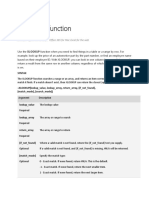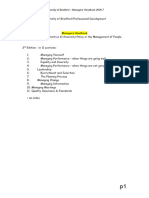0% found this document useful (0 votes)
499 views3 pagesExcel XLOOKUP Guide
The document provides a guide to using the XLOOKUP function in Excel. It includes the syntax, arguments, examples, and tips for using XLOOKUP. The arguments are lookup_value, lookup_array, return_array, and optional arguments if_not_found, match_mode, and search_mode. Examples demonstrate basic lookup, handling not found values, approximate matching, reverse lookup, error handling, and binary search. Tips cover using wildcard characters, array mode, dynamic arrays, and error handling with XLOOKUP.
Uploaded by
Khalid KunariCopyright
© © All Rights Reserved
We take content rights seriously. If you suspect this is your content, claim it here.
Available Formats
Download as PDF, TXT or read online on Scribd
0% found this document useful (0 votes)
499 views3 pagesExcel XLOOKUP Guide
The document provides a guide to using the XLOOKUP function in Excel. It includes the syntax, arguments, examples, and tips for using XLOOKUP. The arguments are lookup_value, lookup_array, return_array, and optional arguments if_not_found, match_mode, and search_mode. Examples demonstrate basic lookup, handling not found values, approximate matching, reverse lookup, error handling, and binary search. Tips cover using wildcard characters, array mode, dynamic arrays, and error handling with XLOOKUP.
Uploaded by
Khalid KunariCopyright
© © All Rights Reserved
We take content rights seriously. If you suspect this is your content, claim it here.
Available Formats
Download as PDF, TXT or read online on Scribd
/ 3

































































